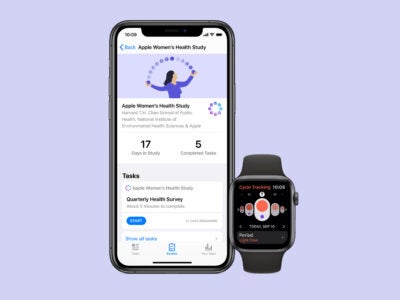Throughout 2021, the Apple Women’s Health Study team presented analyses and findings in a variety of ways.
Two study updates with preliminary data analysis
Two study updates provided preliminary insights obtained from data collected from participants.
A wide range of menstrual cycle symptoms among study participants was reported in a study update released in March 2021. The study update showed that 83% of the participants that tracked menstrual symptoms reported abdominal cramps. Bloating and tiredness were the second and third most tracked symptoms, logged by more than 60% of participants. 37% of participants logged diarrhea and sleep changes, which are less widely recognized menstrual symptoms.
A second study update presented preliminary data showing that the proportion of participants attempting to conceive decreased during the COVID-19 pandemic. From May 2020 to October 2020, this proportion dropped from 6.1% to 4.9%—almost 20%. Pregnancy attempt rates among participants then remained consistent at around 5% from November 2020 through May 2021.
The study team will expand upon the insights gleaned from these preliminary data analyses and publish formal study results in the scientific literature.
First scientific publication
The study’s first scientific publication, “Design and Methods of the Apple Women’s Health Study: A Digital Longitudinal Cohort Study” was published by the American Journal of Obstetrics and Gynecology (AJOG) in October 2021.
The publication describes the design and methods of the ongoing study and provides demographic characteristics of the first 10,000 participants recruited through May 2020. It also sets the stage for future investigations aimed at facilitating discovery in women’s and reproductive health.
Engaging with experts at events
Study team members engaged in conversations about digital health research at events and conferences.
In June 2021, the team led an interactive session on “Digital Innovations for Women’s Health Research” during the 2021 National Summit on the Health of Women. The team emphasized the need to expand menstrual health research to fill critical gaps, the benefit of leveraging the expertise of collaborators, and the use of digital tools to allow for participants to contribute meaningful data to research throughout their daily lives.
Shruthi Mahalingaiah, one of the study’s principal investigators, presented a poster (AWHS-Poster-SRI-2021) about the design and methods of the Apple Women’s Health Study at the 68th Annual Meeting of the Society for Reproductive Investigation (SRI) in July 2021. The annual meeting brings together researchers to discuss improving reproductive health outcomes.
Shruthi also joined the principal investigators of the other two studies in the Research app, the Apple Hearing Study and the Apple Heart and Movement Study, for a panel discussion about the potential impact of virtual, longitudinal studies on improving health outcomes. The panel was organized by the American Heart Association (AHA) as part of the Scientific Sessions and took place in November 2021.
Looking ahead
The Apple Women’s Health Study aims to gain a deeper understanding of how certain demographic and lifestyle factors could have an impact on menstrual cycles and gynecologic conditions including infertility, menopause, and polycystic ovary syndrome (PCOS).



